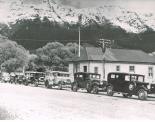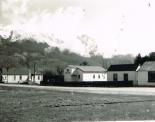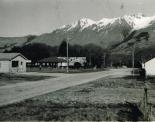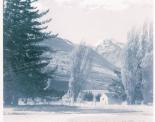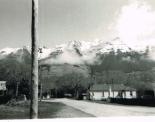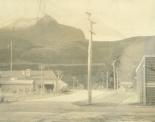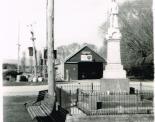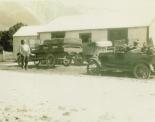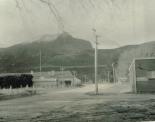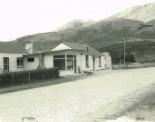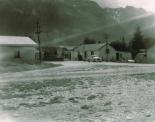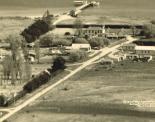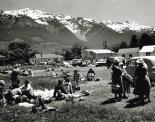SCOTS HISTORY AND PLACE NAMES Gallery
Last month Vince Jones gave a talk on the Scots history of the region.Many people commented on how much they enjoyed it, so we asked if he would share it as part of this month’s Historic Photo of the Month, and he kindly has.
Our photos this month are all views of Mull Street at different times throughout Glenorchy History where it’s possible to see the changing face of the village over time. Some of the main features – the Post and Telegraph Office (now the G.Y.C.) has a date of 1913 in early photos and the War Memorial has been a feature on Mull St. since 1924. You can see the changing shape of the Woolshed ruins in the background of different photos and across the road, Glenorchy Motors has been in the Smith family since 1944, and before that was owned by the Knowles family. The Hall was built in 1943 by the Miners, so you’ll see in early photos, it is noticeably absent! In the photos of the picnic from the Centennial celebrations of November 1962 there is a very different view from the south side of Mull Street where today the Pub fills that space. The Glenorchy Store is featured in many photos as it was on Mull Street to the east of the War Memorial and Hall until it burned down on February 28, 1968.
Mull Street gets its name, as do many places in Glenorchy from Scotland. Here’s Vince to tell us more about role Scots have played in shaping our local and regional history…
Scots History of the Region
The Scots migration to Otago began in 1848 and it was an organised movement. John McGlashan, Thomas Burns and William Cargill organised a migration venture through the Free Church of Scotland. In the main they were people of the Border country. They were not victims of the enclosure movement that had decimated the Highlands but rather they were economic migrants in search of a better life. The 19th century saw the greatest migration of people ever. They migrated from Europe to the United States, Canada, Australia and New Zealand. Within Europe there was a migration, from the East to the West. Much of it was Russian Jews escaping oppression. So the reasons for migrating were for economic advancement and to escape religious and ethnic oppression – the same as they are today.
Unlike the settlement of Canterbury where the idea was to replicate the English class system and to introduce the productive classes, the landed gentry, the tradesmen and household staff, Otago was to be egalitarian. The followers of the Free Church of Scotland was from where the migrants were drawn. They were Presbyterian but rejected church hierarchical structures. They believed that each church group should select its own minister and not have them appointed from above. The Free Church ran parish schools in Scotland which encouraged learning and advancement for bright students irrespective of their background. Education was important in Scotland and for much of the 19th century there were more universities in Scotland than in England. The Scottish migrants were not English with an accent, they were their own men and women.
Once established in Dunedin the settlers gradually began to spread out in the neighbouring areas, often on 50 acre blocks. Sheep were imported and with that settlers spread out into the Otago and Southland hinterland looking for unoccupied land. Rees settled in Queenstown and pushed on up the Head of the Lake. At this time gold was discovered in Gabriel’s Gully and this led to a migration of miners from abroad, especially from the Australian gold fields, and from within New Zealand. If the Scottish settlers were God fearing, the miners certainly were not. The Presbyterian settlers for all their religion seldom had an event where the whisky did not flow freely but this was the only thing they had in common with the miners. The mining areas really were the Wild West where gambling, drinking and loose women were the norm. This did not sit well with the Presbyterians.
And so mining came to Glenorchy but in a much smaller way than for Skippers, the Moonlight, the Fox and Queenstown. The initial rush was over relatively quickly and more industrialised mining in a small scale continued with the Dart dredge and at the Invincible.
All the way through there were Scotsmen involved. Alfred Duncan, along with George Simpson brought the first sheep to Glenorchy for Rees. It is worth remembering that not long after the settlement of Dunedin that the Scottish proportion of the total provincial population was only a third. English people such as the Valpys, who moved to Glenorchy to farm in the late 1880s, also played a big part in the settlement of Otago. So the early Scottish settlers to Glenorchy were probably in about that proportion. There is a record of a big punchup between Irish miners versus everyone else at Campbelltown.
So what legacy have the Scots left to Glenorchy? Firstly street names, Mull, Oban, Islay, Argyle, Coll, Jura and Sheil. With the exception of Sheil these are all islands in the Inner Hebrides or townships on the adjacent mainland in the Argyll/Bute district. The river Orchy and Glenorchy are in the same district. Kinloch, simply means the Head of the Lake, a term that until quite recently was used to identify the district. We have the Bucklerburn, the Beansburn, the Rockburn and the Routeburn where the word burn means a creek or a stream. Bucklerburn was the name of Alfred Duncan’s father’s farm. In addition, we have crib for bach, and wee, meaning small. There was a Caledonian Society but its role seems to have been to organise a Ball once a year and the committees over the years had suspiciously English names. One Scottish custom which survived until the 1980s was that of “first footing” on New Year’s Eve.
The meeting to set up the library took place in July, 1891, which perhaps shows the Scottish valuing of education and despite what I have said about the gold miners there was a well-stocked library in the Moonlight.
My own belief that a legacy of the Scottish settlement that was brought to Otago and Southland was egalitarianism, an aversion to ostentation and a willingness to live a relatively frugal lifestyle. There was a rejection of the class system of England and not the need to build grand houses to demonstrate your status or wealth, though there were exceptions such as Hallenstein and Teschmaker, but they were not Scottish. Where this attitude was found, such as with Butement, the resentment is manifest. Schools were for education and the Canterbury question, “What school did you go to?” does not exist in Otago and Southland.
During the boom of the 1980s it was said that Aucklanders spent the money they would earn in a years’ time, Wellington people spent the money they would earn in six month’s time, Christchurch people spent the money as it came in, but the people of Otago and Southland spent the money they earned two years ago. In as much as this is true it is surely a legacy of Scottish Presbyterian fiscal prudence. But they also left a legacy of integrity in commercial dealings. Until the arrival of dairy farmers from up north, you could order goods with an account to be sent in the mail and the trust was honoured. The dairy farmer’s tactic of saying they would only pay a percentage of the bill and you could sue for the rest or refusal to pay at all, was a real surprise to many tradesmen to their cost.
The Scottish settlers left us not only place names but their real legacy is the value they placed on integrity and decency in dealing with their fellow citizens.


